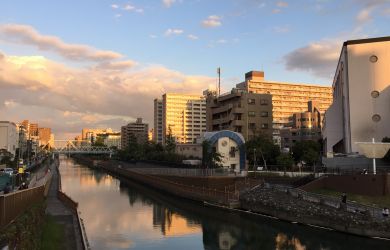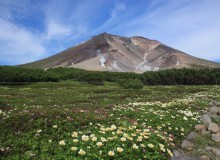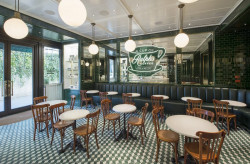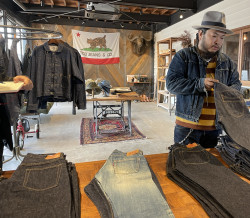
August 4, 2006
Escape to the wilderness
Return to nature on two of Japan’s most remote islands
By Metropolis
Originally published on metropolis.co.jp on August 2006

Photos by Richard Kimber
Bright lights, nightlife, fashion and high society; you won’t find any of these on Rishiri-to and Rebun-to. In fact, the beauty of these remote islands off the northwest coast of Hokkaido is that you won’t find very much at all, apart from stunning scenery, picturesque hiking trails and enough nature to keep you occupied for many self-indulgent days of aimless wandering.
It’s pretty difficult to get much further away from Tokyo than here, but worth every minute of the journey time. As soon as you have escaped the relative modernity of the islands’ ferry terminals, you are greeted by seaweed washing lines gently flapping in the breeze, endlessly winding deserted roads, and sea air so fresh it’s almost medicinal.
Rishiri-to is essentially little more than a majestic lone volcano, surrounded by just enough land to make it more than simply a big lump of rock in the sea. Most people come here to climb the 1,700m cone of Mount Rishiri, where panoramic views of the island, neighboring Rebun-to and, on a clear day, the Hokkaido coastline, are all fine rewards for your efforts. There are a variety of trails to the top, catering to all levels of experience and energy.

Alternatively, you can set off on a tour around the island in the luxury of a bus, or if you’re feeling more adventurous, the luxury of a hired shopping bike. There is a cycling trail that leads around most of the 60km coastline, and there’s no better way to take in the scenery.
In between getting carried away with the constant photo opportunities, there are just enough small eateries en route to stop off and stock up while watching the snow-capped Mount Rishiri melt into the fluffy clouds of a blue sky.
To see one of the best views of the mountain, you need to get on a ferry and head next door to Rebun-to. There is no volcano on offer here, but with rolling green headland and hiking trails that weave as far as the eye can see, it feels even more remote.
Rebun-to is most famous for its hundreds of species of wildflowers but, nature aside, it’s also home to the most bizarrely memorable inn I have ever visited. The Momoiwa-so Youth Hostel is well known in Hokkaido, and not just because of its breathtaking shoreline location.
I had been assured by the landlady at my hostel on Rishiri-to that I would have a “lively” time staying there. She declined to explain why, but I began to get an idea when, much to the amusement of passengers who were staying elsewhere, I was met at the ferry terminal by a group of drumming and flag-waving hostel staff complete with a roll of makeshift red carpet.

The hostel recently celebrated its 40th anniversary, and every night from June to October there’s a compulsory three-hour session of singing, dancing and hand-holding that climaxes with everyone gathering outside to serenade the sunset.
Add to this an even more enthusiastic send off the following morning, and you begin to understand why most of the other guests were returning for their second, tenth, or, in one case, 21st time.
The manager of the hostel, who goes by the name of Do, told me the aim was to create a family atmosphere for all the guests, and to ensure “everyone is smiling all the time.” It was a wonder he could tell me anything at all because he, and the other staff, barely had enough voice left to speak during the day—despite my visit coming only a few weeks into the hostel’s entertainment season.
There are all manner of hiking trails around Rebun-to, ranging from epic eight-hour treks through forests and over cliffs, to more sedate tours of the flower fields and headland. There are also a couple of fishing villages that are essential fuel stops for the local specialty of fresh uni.
Returning to the Hokkaido mainland felt like a disappointingly early return from the wilderness, and then I remembered, with a smile, that I was still a good 1,500km away from my crammed daily commute into Shinjuku.
The best time to visit Rishiri-to and Rebun-to is June-October, when the scenery and weather are at their most beautiful. To get to the islands, you must take a ferry from the rather uninspiring port town of Wakkanai. You can fly direct to Wakkanai from Tokyo, or if traveling elsewhere in Hokkaido, take a train or bus from Sapporo. The best move is to take the overnight service, which drops you off just in time for the early morning boat to the islands. The ferries operate four times a day, more frequently for the shorter trip between the two islands. On Rishiri-to, the Rishiri Green Hill Youth Hostel (01638-22507, ¥2,900) is a comfortable inn with tatami rooms; there’s also a popular campsite on the way up the volcano where you can pitch a tent or stay in small cabins. The best place to eat is Aji-no-ichi, a ramen joint behind the ferry terminal. Contact Momoiwa-so Youth Hostel on Rebun-to at 01638-61421; nightly rates are ¥2,800. The food there is good, or you can head to the fishing village of Moto-chi for tasty fresh seafood.
[geo_mashup_map]







